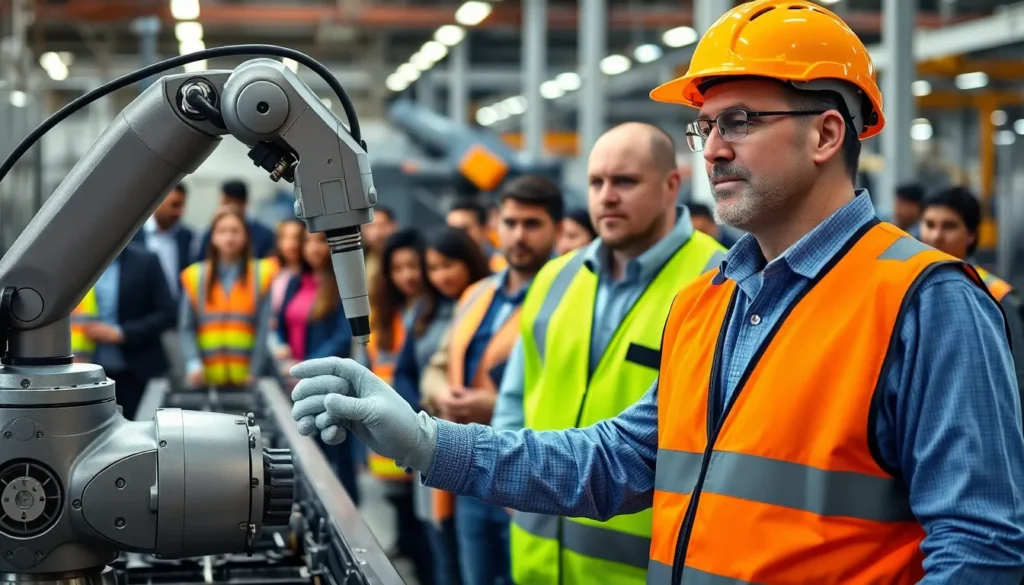Table of Contents
ToggleIn a world where even your coffee machine has a personality, automation technology is the unsung hero of modern life. It’s not just about robots doing the cha-cha while you sip your latte; it’s about transforming everyday tasks into seamless experiences. Imagine a life where mundane chores vanish faster than your last New Year’s resolution. That’s the magic of automation.
From smart homes to AI-driven factories, automation is revolutionizing industries and making life a whole lot easier. It’s like having a personal assistant who never needs a coffee break. As businesses scramble to keep up with the pace of technological advancement, understanding automation technology is no longer optional—it’s essential. So buckle up and get ready to explore how this game-changing tech is reshaping our world, one automated task at a time.
Overview of Automation Technology
Automation technology represents a crucial advancement in how tasks and processes operate across various sectors. This technology encompasses software, hardware, and AI systems designed to enhance efficiency and accuracy. Integration of automation leads to improved productivity by minimizing human error and reducing the time required for task completion.
Smart homes serve as a prime example of automation technology in action, allowing for seamless control of lighting, climate, and security through user-friendly interfaces. Similarly, industries deploy automation for tasks like inventory management and assembly line operations, which results in quicker turnaround times and lowered operational costs. Factories utilize robotic systems to perform repetitive tasks, while humans focus on more complex responsibilities.
Data analytics plays a vital role in automation technology, as it aids organizations in interpreting information and making informed decisions. Businesses implementing automation can respond promptly to market changes, thus staying competitive. Several sectors, including healthcare, manufacturing, and logistics, experience significant enhancements through automation practices.
Challenges exist, including potential job displacement and the need for worker retraining. Companies recognize the importance of addressing these issues to foster a harmonious integration of technology and human labor. Moreover, regulatory frameworks and ethical considerations must evolve alongside technological advancements to ensure responsible automation deployment.
The impact of automation technology extends beyond individual businesses; it influences economic growth and societal progress. By investing in automation, organizations can expect not only to streamline their operations but also to contribute to overall innovation in their respective fields.
Types of Automation Technology

Automation technology encompasses various types, each tailored to enhance efficiency in distinct environments. Understanding these types is critical for maximizing their potential benefits.
Industrial Automation
Industrial automation focuses on the use of control systems for operating equipment in manufacturing plants, boilers, and heat treating facilities. Robotics plays a significant role here, handling repetitive tasks like welding or painting with precision. Data analytics enhance monitoring and maintenance, allowing for proactive management of machinery. Companies experience increased productivity levels while minimizing operational costs due to reduced human error. Tony, an automation specialist, emphasizes using programmable logic controllers for precise operations. This technology supports supply chain improvements, striving for faster production and delivery cycles.
Home Automation
Home automation revolves around the integration of technology for managing household systems. Smart devices, including thermostats, lighting, and security cameras, connect seamlessly to user interfaces. Homeowners enjoy increased convenience and energy efficiency through customizable settings. For instance, users can adjust heating remotely, optimizing comfort while saving electricity. Voice-activated assistants provide hands-free control, offering a modern solution for busy lifestyles. Security features enhance safety, allowing for real-time monitoring of premises. As homeowners embrace these advancements, they discover a more streamlined and secure living experience.
Office Automation
Office automation enhances productivity by simplifying daily tasks within a workspace. Software solutions streamline document management, email communication, and scheduling tasks. Cloud services facilitate collaboration among team members, fostering a more integrated approach to projects. By using tools for document sharing, revisions become efficient and organized. Workflow automation reduces the likelihood of errors in repetitive tasks. Employees appreciate the time savings, allowing them to focus on strategic initiatives. Integration of Artificial Intelligence in office settings supports data-driven decision-making, empowering organizations to respond to market dynamics quickly.
Benefits of Automation Technology
Automation technology offers numerous advantages that enhance operational effectiveness across various sectors.
Increased Efficiency
Efficiency improves significantly with automation technology. Tasks that once required extensive human intervention now complete more rapidly through automated systems. Companies benefit from reduced task completion times, enabling them to allocate resources more effectively. For example, assembly line operations streamline production, leading to higher output levels. Industries adopting automation often see enhanced workflows as machines handle repetitive tasks, freeing employees for more complex activities. The integration of software and AI promotes instant information processing, allowing organizations to react quickly to changes in demand.
Cost Savings
Cost savings represent a crucial benefit of automation technology. Businesses reduce labor costs through automation by minimizing the need for manual labor on repetitive tasks. Operating expenses decrease as automated systems improve accuracy and reduce errors, leading to less waste. Rapid turnaround times lower holding costs for inventory, enhancing cash flow. For instance, retail chains utilizing automated inventory management often cut expenses related to stock mismanagement. By investing in automation, companies achieve a higher return on investment due to increased productivity and lower operational costs.
Enhanced Safety
Enhanced safety stands as another critical advantage of automation technology. Automated systems mitigate risks associated with hazardous tasks, protecting workers from injury. Robotics can perform dangerous activities in manufacturing environments, reducing the likelihood of accidents. Enhanced data analytics driven by automation also allows for better safety monitoring, leading to more informed decisions regarding workplace conditions. Organizations benefiting from these technologies often report fewer workplace incidents and improved employee morale, creating safer and more productive environments for all staff.
Challenges and Considerations
Automation technology presents various challenges and considerations that require careful evaluation. Businesses must address these issues to ensure effective implementation and minimize negative impacts.
Job Displacement
Job displacement frequently arises from automation. Certain roles become obsolete as machinery and software take over repetitive tasks. While this can lead to increased efficiency, affected workers face significant challenges. Retraining programs are essential for helping employees adapt to new demands in the workforce. Research indicates that sectors like manufacturing and retail experience the highest job losses due to automation. Therefore, collaboration between companies, governments, and educational institutions proves necessary to create pathways for reskilling workers. Addressing this displacement fosters smoother transitions into emerging job markets that automation technology creates.
Security Concerns
Security concerns dominate conversations about automation technology. Systems relying on connectivity expose vulnerabilities to cyberattacks. This risk can lead to data breaches and compromised sensitive information, threatening both businesses and individuals. Implementing robust cybersecurity measures becomes essential for safeguarding automated systems. Continuous monitoring and regular updates significantly reduce threats. Employees must also receive training on best practices for cybersecurity. Organizations that prioritize security measures not only protect data but also maintain customer trust and business integrity. A proactive approach to security helps mitigate risks associated with automation.
Future Trends in Automation Technology
Automation technology continues to evolve rapidly, influencing various industries significantly. Key trends include artificial intelligence integration and advancements in robotics.
Artificial Intelligence Integration
AI integration plays a pivotal role in enhancing automation capabilities. Machine learning algorithms improve systems by enabling them to learn from data, adapt to changes, and optimize performance. Companies utilize AI to analyze trends, forecast demands, and streamline operations. By automating customer service with AI chatbots, businesses reduce response times and enhance customer experiences. Enhanced decision-making arises from intelligent data analytics, supporting organizations in understanding market dynamics better. Additionally, predictive maintenance becomes possible, allowing companies to address equipment issues before they escalate, thereby minimizing downtime.
Robotics Advancements
Robotics technology is advancing at an impressive rate, transforming how industries operate. Sophisticated robots now perform complex tasks previously thought impossible, such as delicate surgeries and intricate assembly processes. Autonomous mobile robots navigate warehouses efficiently, reducing the need for human intervention in repetitive tasks. Collaborative robots or cobots work alongside humans, augmenting their capabilities and ensuring safety. Companies benefit from enhanced productivity through the integration of robotics into their workflows. As robotics technology progresses, it leads to even greater efficiency gains, making businesses more competitive and responsive to consumer needs.
Automation technology is undeniably shaping the landscape of modern life. Its ability to enhance efficiency and productivity across various sectors is transforming how businesses operate and how individuals manage daily tasks. As industries continue to adopt these advancements the potential for growth and innovation remains vast.
However the integration of automation comes with challenges that require careful consideration. Addressing job displacement and ensuring robust cybersecurity measures are essential for a smooth transition into this automated future. By fostering collaboration among stakeholders the benefits of automation can be maximized while minimizing its drawbacks.
Looking ahead the synergy between automation and artificial intelligence promises even greater advancements. As technology evolves it’s crucial for businesses and individuals alike to stay informed and adaptable to fully leverage the advantages automation has to offer.




